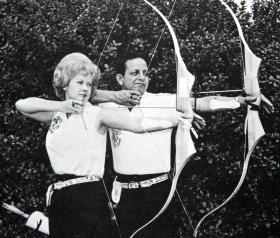

TAHLEQUAH - At age 92, Joe Thornton doesn’t chase rabbits with a stick and string anymore.


But Time magazine once called this Oklahoma man "a modern William Tell.” Forty-eight years ago, Thornton was the best archer in the world.
He won the world archery championships in Oslo, Norway, in 1961, breaking three world records. He dominated other world-class archers that year, winning the tournament with ease.
"I could have thrown away my last dozen arrows and still won the world championship,” Thornton said.
Thornton came by his gift naturally because he is a full-blooded Cherokee Indian, Time magazine reported in 1961.
Actually, he is 11/16 Cherokee. And although gifted with a bow, Thornton worked hard to become a world champion.
"I would try to practice about three hours a day,” he said. "I studied other archers, what they did and how they did it, and of course, I read everything I could about it.”
Humble beginnings
Thornton was born in 1916 in Adair County where he finished the eighth grade before attending the Seneca Indian School in Wyandotte.
A year later, he went to the Chilocco Indian School near Newkirk where he finished high school.
It was at Chilocco where Thornton first picked up a bow. He and his classmates made crude homemade bows and arrows for hunting.
"We would kill rabbits, roast ‘em and eat ‘em,” Thornton said.
Killing a rabbit with a bow and arrow wasn’t hard, he said, "if you are sneaky.”
Military service
Thornton joined the U.S. Army in 1934 where he spent three years at Fort Sill where he was field radio operator.
After leaving the Army, he moved to Stilwell then Tahlequah bebore rejoining the military in 1943 to serve during World War II in the Signal Corps.
As part of the War Department Radio Station in Alexandria, Va., Thornton worked on transmitters to ensure the Pentagon could send messages to U.S. Army units throughout the world.
He received a Presidential Unit Citation Award for his service.
Rediscovering archery
Thornton returned to Tahlequah when the war ended and opened a radio and TV repair business. Ten years later, he was reintroduced to archery by an employee.
"In the shop I would hire college boys to help out with the work, put up antennas and little things like that,” he said.
"One of the boys had messed a little with modern archery and told me about archery clubs and tournaments around the state. I bought me a bow and practiced and start shooting in these tournaments.”
By 1959, Thornton was winning tournaments across the state. He shot a score so high in the 1960 state tournament that he was encouraged to try out for the U.S. Archery Team.
In 1961, the world archery championships were being held in Norway. Thornton traveled to Chicago to attempt and make one of three spots on the team.
He finished fourth, but just by a single point. He could still compete in Oslo if he paid his own way.
The Tulsa Archery Club and local civic groups raised the $1,000 necessary to send Thornton to Norway.
On top of the world
Thornton, at age 45, competed against archers from 15 nations in Oslo, some only half of his age.
The greatest thrill in his life was seeing the American flag flashing by his name on the scoreboard, indicating that he was the winner.
He returned from Norway as king of the archery world. He was met at the Tulsa airport and given a key to the city.
In Tahlequah, "Joe Thornton Day” was proclaimed and almost 7,000 people turned out for the parade in his honor.
Thornton rode on the city’s fire engine behind the high school marching band.
Glory days
In 1963 and 1965, Thornton won silver medals at the World’s Archery Championships and was a member of three gold medal winning U.S. archery teams (1961, ‘63, and ‘65).
In 1962, he met his wife, Helen, who bought a bow from Thornton and became his pupil and then his wife.
Helen Thornton, 70, was a member of two gold medal winning U.S. archery women’s teams in 1963 and 1965.
Joe Thornton won several state championships in the 1960s and even a national title at age 54 in 1970.
Although he never got to shoot in the Olympics, Thornton was instrumental in seeing that archery became an Olympic sport.
He served three years on the Board of Governors of the National Archery Association, which pushed to get archery in the Olympics.
It finally happened in 1972. Both Joe and Helen Thornton tried to qualify for the U.S. Olympic team but failed.
Trading a bow for a hoe
The couple now live quietly in Park Hill, a community near Tahlequah, where memories of their past glory adorn their home.
Today, Thornton rarely picks up a bow.
"I can’t pull those bows I shot back then,” he said.
Instead, he passes most of his time by gardening, making Indian jewelry and woodworking.
But he acknowledges that he misses the competition and the days when he was the best archer in the world.
"Oh, yes,” he said. "You hate to get old.”
Born: Aug. 2, 1916 in Stilwell
Thornton’s awards
→1961: Gold medalist in World Archery Championship in Oslo, Norway (broke three world records)
→1962: Won British International Trials Archery Championship
→1963: Silver medalist in World Archery Championship in Helsinki, Finland
→1965: Silver medalist in World Archery Championship in Vasteras, Sweden
→1970: Won National Archery Championship in Oxford, Ohio
→1978: Inducted into the American Indian Athletic Hall of Fame
→2004: Inducted into the Oklahoma State Archery Association Hall of Fame along with his wife, Helen